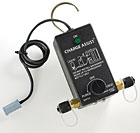
The Charge Assist can be used when a system is installed, as well as during routine maintenance, as shown above.
PHOENIX - Magic Touch Mechanical has a lot of credentials, such as being a certified contractor for Southwest Gas, Arizona Power Service, Salt River Project, Honeywell, and Home Depot. According to president Rich Morgan, the company also is a member of the Better Business Bureau, Arizona Heat Pump Council, Electric League of Arizona, Blue Energy Institute, the Employee Network, and is a certified Trane Comfort Specialist and Distinguished Trane Dealer of the Year.
Put it all together and it makes for one very busy company especially during the busy season, with a lifetime workmanship guarantee and 100 percent satisfaction guarantee. If the work isn’t done properly, it could add up to a lot of nonbillable time.
One way the contractor achieves high customer satisfaction and a minimum amount of callbacks is by making sure the jobs are done right from the get-go. That means, among other things, making sure the refrigerant charge is calculated correctly.
For some types of equipment, like dual-compressor equipment, “It was quite the process,” said Morgan. The company did what it needed to do to achieve 100 percent charge accuracy, but this was necessarily time-consuming. “We had 100 percent accuracy,” said Morgan, “but that was because we take quite a bit of time. I made sure from the charge aspect that everyone was properly trained on it. We don’t want any newbies charging the machine.”
Sometimes a technology comes along that helps a contractor in many ways. For Magic Touch, Trane’s new Charge Assist™ is one such technology. It is an automatic self-charging feature on higher-efficiency Trane systems.
“The Charge Assist is part of the unit itself,” explained Morgan. “It’s part of the electronics on it. It determines balance points, etc. There is a tool that the guys can hook up to their refrigerant tanks and hoses, and the tool tells them when they are getting close to the full charge.” It isn’t necessary to use, he added, but it can be convenient if the tech does something else while the unit is charging. “You can also go direct from the machine to your refrigerant tank.”
Improper refrigerant charging has been identified as a major problem by the Environmental Protection Agency (EPA), whose studies show that more than 70 percent of residential air conditioning systems are not properly charged.
“As a result,” stated Trane, “homeowners face higher energy costs, reduced reliability, and faster wear and tear because systems do not operate at maximum efficiency.”
PART OF COMFORTLINK II
Charge Assist is a feature on the manufacturer’s new ComfortLink™ II systems. The built-in feature delivers the precise amount of refrigerant before shutting itself off and returning control of the system back to the comfort control. It calculates the correct charge, meaning that the installer doesn’t need to calculate superheat and subcooling.It can be used when a system is installed, as well as during routine maintenance, to ensure system reliability. During maintenance, the feature indicates if a unit is under-or over-charged, enabling the technician to add or recover refrigerant and put the system back in balance. “Charge Assist provides a method for automatically adding refrigerant more accurately than has been possible in the past,” said the manufacturer.
Air conditioning systems that are out of balance result in unnecessary wear and tear on the compressor, impacting reliability as well as energy costs, the company explained. Furthermore, the unit may not perform to the stated efficiency rating.
ComfortLink II connects all communicating components of a home’s HVAC system, while providing the option of remote phone access to the system. Communicating technology is built into the company’s highest-efficiency products, allowing them to communicate with each other digitally. The interfaces enable all communicating components in the system to be automatically and properly charged, configured, and calibrated. The system also runs its own self-diagnostics to ensure proper airflow, heat source configuration, blower timings, and humidity control.

Trane’s new Charge Assist.
The system “offers a distinct value proposition for dealers,” said Randy Scott, vice president of product systems management for Trane. “Installation is simplified by the plug-and-play feature, enabling a technician to walk away and handle separate tasks, such as installing other components or training a customer on the system’s operation.”
Said Morgan, “One of the comments I’ve received from our installers is, ‘it’s kind of a set-it-and-forget-it mode.’ Instead of having to sit there for half an hour dialing in the charge, they just set the machine up and let it go.
“At this point, we don’t even worry about it anymore,” he continued. “If somebody is having an issue with getting the charge correct, this would be a wonderful product.”
For his company, which was already very careful about getting the charge correct, the new system means substantial time savings at the jobsite, especially with just six installers and several million in sales volume in the general Phoenix area.
A complete system connected by ComfortLink II consists of the following Trane components:
• The XL19i communicating air conditioner or heat pump;
• The XC95 variable-speed, modulating, three-stage communicating furnace or 2/4TEE communicating air handler;
• The XL900 Series communicating comfort control; and
• The optional telephone access module.
“We’ve taken the most complex system to install and made it the easiest for dealers,” Scott said. “With a minimum of training, any installer can skillfully install high-efficiency units and deliver on the consumer’s performance expectations.”
For more information, visit www.trane.com.
Publication date:06/09/2008

Report Abusive Comment